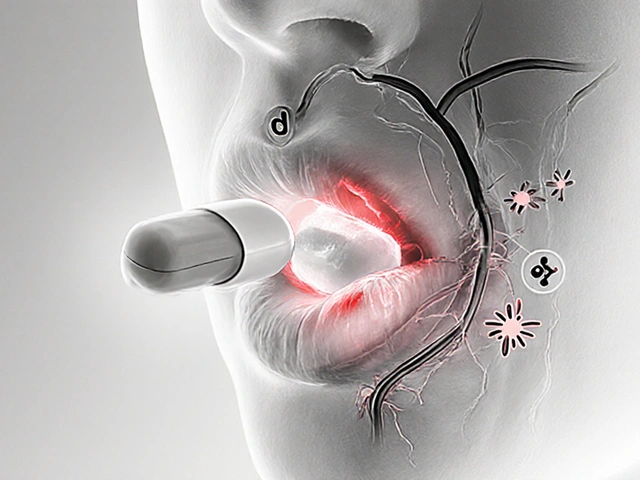If you have a shellfish allergy, eating out isn’t just about picking a good restaurant-it’s about avoiding a medical emergency. Unlike food intolerances, shellfish allergy triggers your immune system to overreact to proteins in shrimp, crab, lobster, clams, and other sea creatures. And the danger isn’t always obvious. You might think avoiding shrimp is enough, but cross-reactivity means even a bite of crab or a splash of seafood broth could send you to the ER. The good news? With the right knowledge, you can eat out safely-and confidently.
Why Shellfish Allergy Is Different
Shellfish allergy is one of the most common and severe food allergies in adults. While many kids outgrow allergies to milk or eggs, shellfish allergy usually lasts a lifetime. The main culprit isn’t just one protein-it’s tropomyosin, a muscle protein found in nearly all shellfish. This protein is so stable that cooking doesn’t destroy it. That means grilled shrimp, fried calamari, or simmered seafood soup all carry the same risk. What makes this even trickier is that tropomyosin looks almost identical across crustaceans (shrimp, crab, lobster) and mollusks (clams, oysters, mussels). Studies show that if you’re allergic to shrimp, you have a 75% chance of reacting to crab or lobster. But here’s the surprise: only 15-20% of people allergic to crustaceans react to mollusks. So, you might be able to eat scallops even if you can’t touch shrimp. But without testing, you won’t know for sure.False Alarms: When Allergy Tests Lie
Standard allergy tests-skin pricks or blood tests for shellfish extract-can give false positives. Why? Because your immune system might be reacting to something else entirely: dust mites or cockroaches. Dust mites are tiny bugs living in your bedding, carpets, and furniture. Their bodies contain a protein almost identical to tropomyosin. In places with high humidity-like Wellington, New Zealand-up to half of people allergic to dust mites test positive for shellfish. But they don’t get sick when they eat shrimp. That’s not an allergy. That’s cross-reactivity. A 2025 study in Frontiers in Allergy found that 68% of people with dust mite allergies had positive blood tests for shellfish, even though they’d never had a reaction. That’s why doctors now recommend component-resolved diagnostics. Instead of testing for “shellfish,” they test for specific proteins like tropomyosin and SCBP. If your IgE antibodies target tropomyosin, you likely have a true shellfish allergy. If they’re targeting something else, you might be safe with certain shellfish.Which Shellfish Are Safe? The Cross-Reactivity Breakdown
Not all shellfish are created equal. Here’s what the data says:- Shrimp, crab, lobster, crawfish: 75-92% cross-reactivity. If you react to one, assume you react to all.
- Clams, oysters, mussels, scallops: Only 15-20% cross-reactivity with crustaceans. Some people with shrimp allergy can eat these safely.
- Fish: No cross-reactivity. Shellfish and fish are completely different. If you’re allergic to shrimp, you can usually eat salmon or cod.

Dining Out: The Real Danger Isn’t the Menu
The biggest risk when eating out isn’t the dish you order-it’s what’s hiding in plain sight. A 2022 survey of 1,200 people with shellfish allergies found that 68% had an accidental reaction while dining out. Nearly a quarter needed epinephrine. Most reactions happened not because of shellfish on the plate, but because of:- Shared fryers: Oil used for fried shrimp contaminates fries, onion rings, or chicken tenders.
- Shared grills: A burger grilled next to shrimp skewers picks up traces.
- Hidden ingredients: Soy sauce, fish sauce, oyster sauce, and seafood stock are common in Asian cuisine and often contain shellfish.
- Staff confusion: Only 37% of servers can correctly identify shellfish in dishes, according to a National Restaurant Association study.
How to Eat Out Safely: 5 Proven Strategies
You don’t have to avoid restaurants. You just need a plan.- Call ahead. Don’t wait until you arrive. Call 24 hours in advance. Ask: “Do you have a dedicated fryer? Do you use shellfish in stocks or sauces? Can I speak to the chef?” Restaurants that take food allergies seriously will welcome the call.
- Use a chef card. These are printed cards (or digital ones on your phone) that list your allergy in clear, simple language. The Food Allergy Research & Education (FARE) card is available in 15 languages. It says: “I am allergic to shrimp, crab, lobster, and all shellfish. Cross-contact with these foods can cause a life-threatening reaction. Please use clean utensils, gloves, and surfaces. Do not use shared fryers or grills.”
- Avoid seafood restaurants. 87% of reactions happen in seafood-focused places. Even if they claim to have “allergy protocols,” the risk is too high. Stick to places with diverse menus.
- Ask to speak to the chef. Servers aren’t trained to handle allergens. Chefs are. A 2021 survey found that 78% of kitchen staff misunderstand “gluten-free” as “safe for allergies.” Don’t settle for a server’s guess. Get the person who cooks the food on the line.
- Use apps like AllergyEats or Nosh List. These apps let users rate restaurants based on how well they handle allergies. Nosh List has data from over 120,000 users. Look for places with 4+ stars and recent reviews from people with shellfish allergies.
What to Carry: Your Emergency Kit
Even with the best planning, accidents happen. Always carry:- Two epinephrine auto-injectors (EpiPen or similar)
- A medical alert bracelet that says “Shellfish Allergy”
- A printed copy of your allergist’s emergency plan
What’s Changing: New Tools and Hope
The field of food allergy is advancing fast. In 2024, the FDA approved a new diagnostic test called ImmunoCAP ISAC 112. It checks for 112 allergen components at once-including tropomyosin, SCBP, and cockroach proteins. This means fewer false positives and more accurate diets. There’s also promising research in immunotherapy. A 2024 study in The Lancet showed that 70% of adults with shrimp allergy could tolerate small amounts after months of daily, gradually increasing doses under medical supervision. It’s not a cure yet, but it’s a big step toward living without fear. AI tools are helping too. Apps like AllergyMapper, launched in early 2024, scan restaurant menus and flag hidden shellfish ingredients. They’re 85% accurate-better than most servers.Final Thoughts: You’re Not Alone
Shellfish allergy is scary, but it’s manageable. You don’t need to give up dining out. You need to be prepared. Learn your specific triggers. Test for component-specific IgE. Talk to your allergist. Use chef cards. Call ahead. Carry your epinephrine. And don’t be afraid to speak up. The more you know, the safer you’ll be. And the more people you educate, the safer it will be for others too.Can you outgrow a shellfish allergy?
Most people do not outgrow shellfish allergy. Unlike allergies to milk or eggs, which often fade in childhood, shellfish allergy typically lasts a lifetime. Studies show less than 10% of adults lose their sensitivity over time. Always consult your allergist before reintroducing shellfish-even if you haven’t eaten it in years.
Is it safe to eat shellfish if I’m only allergic to one type?
Not without testing. If you’re allergic to shrimp, you have a 75% chance of reacting to crab or lobster due to shared tropomyosin. But only 15-20% of people allergic to crustaceans react to mollusks like clams or scallops. Component-resolved diagnostics can tell you which proteins you’re allergic to. Some people can safely eat scallops even if they react to shrimp.
Do I need to avoid all seafood if I’m allergic to shellfish?
No. Fish like salmon, cod, or tuna are not related to shellfish and do not cause cross-reactions. Shellfish are invertebrates; fish are vertebrates. Their proteins are completely different. You can eat fish safely if you’re allergic to shrimp, crab, or clams-unless you have a separate fish allergy.
Why do I test positive for shellfish allergy but never react when I eat it?
You likely have cross-reactive sensitization, not a true allergy. Dust mites and cockroaches contain proteins very similar to shellfish tropomyosin. If you’re allergic to dust mites (common in humid climates), your immune system may produce IgE antibodies that react to shellfish in blood tests-but you won’t get sick when you eat it. Component testing can confirm this. Talk to your allergist about testing for tropomyosin specifically.
What should I do if I have a reaction while dining out?
Use your epinephrine auto-injector immediately. Don’t wait to see if symptoms get worse. Then call emergency services-even if you feel better after the shot. Anaphylaxis can come back hours later. Inform the restaurant staff so they can help prevent future incidents. Report the event to your allergist and to food safety organizations like FARE.
Are there any restaurants that are reliably safe for shellfish allergies?
No restaurant is 100% safe, but some chains have strong allergen protocols. Chipotle, Panera Bread, and certain local restaurants with dedicated allergen kitchens have lower risk. Use apps like AllergyEats or Nosh List to find places rated by other people with shellfish allergies. Look for reviews mentioning “clean prep,” “separate fryer,” or “chef spoke directly.” Always confirm with staff-even if the app says it’s safe.






Comments
Conor McNamara
November 19, 2025 AT 09:00 AMi read this and immediately thought the government is using dust mites to test us all lol. why do so many people in humid places test positive for shellfish allergy but never get sick? coincidence? i think not. someone’s monitoring our IgE levels. also why are apps like AllergyMapper suddenly popping up? who coded them? check the domain registration. it’s not innocent.
Leilani O'Neill
November 19, 2025 AT 12:11 PMHow quaint. You people treat food allergies like a fashion accessory. In Ireland, we’ve eaten shellfish for centuries without needing a 12-page manifesto on tropomyosin. If you can’t handle a little seafood, maybe don’t leave the house. The real problem is this overmedicalization of everyday life. You’re not allergic-you’re anxious.
Riohlo (Or Rio) Marie
November 21, 2025 AT 09:04 AMOh darling, let’s not pretend this is about science. This is performative health anxiety dressed up in peer-reviewed jargon. Component-resolved diagnostics? Please. You’re just another influencer who bought a $300 IgE test and now thinks you’re a clinical immunologist. The real tragedy? You’ve turned dining out into a hostage negotiation. Where’s the joy in food anymore? It’s all spreadsheets and chef cards now. Boring.
steffi walsh
November 22, 2025 AT 22:32 PMThis is actually so helpful and I’m so glad someone laid it out clearly 💪 I’ve been terrified to try scallops for years and now I’m calling my allergist tomorrow. You’re not alone, and you’re not overreacting. Your safety matters. Let’s normalize asking questions at restaurants-no shame in being cautious. You’ve got this!
Emanuel Jalba
November 24, 2025 AT 05:10 AMOMG I JUST HAD A REACTION AT CHIPOTLE AND THEY USED THE SAME SPOON FOR SHRIMP AND GUAC 😭 I’M SO ANGRY. WHY IS NO ONE TALKING ABOUT THIS?! THEY KNEW. THEY KNEW. I’M SENDING THEM A LAWYER LETTER. ALSO WHY AREN’T THEY LABELING EVERYTHING?! THIS IS A CONSPIRACY. #ShellfishEmergency
Heidi R
November 24, 2025 AT 19:59 PMYou’re all missing the point. The real issue is that people with allergies are too lazy to cook at home. Why are you trusting restaurants at all? If you can’t control the environment, you shouldn’t be eating out. Period. This isn’t about science-it’s about personal responsibility.
Brenda Kuter
November 25, 2025 AT 06:17 AMI went to a sushi place last week and the chef whispered, ‘We use shrimp paste in the tempura batter.’ I ran out crying. My husband says I’m dramatic but he doesn’t get it. I almost died. Now I’m scared to eat anything with soy sauce. What if it’s in my toothpaste? What if my shampoo has shellfish oil? I need a hazmat suit.
Shaun Barratt
November 25, 2025 AT 22:27 PMWhile the article presents a generally accurate overview of shellfish cross-reactivity and diagnostic methodology, it is worth noting that the statistical prevalence of component-specific IgE reactivity varies significantly across geographic populations. For instance, the 68% dust mite cross-reactivity figure cited is drawn from a single-center cohort in New Zealand; extrapolation to North American or European populations may introduce selection bias. Further, the assertion that ‘fish pose no cross-reactivity risk’ remains empirically valid but requires qualification regarding parvalbumin homology in certain elasmobranchs. The recommendation to utilize ImmunoCAP ISAC 112 is sound, though accessibility remains limited in rural clinical settings.
Iska Ede
November 27, 2025 AT 19:57 PMSo let me get this straight-you’re telling me I can eat scallops but not shrimp? And I’m supposed to be grateful? That’s like saying you can drink Diet Coke but not regular. Congrats, I’m now a food scientist with a side of anxiety. Next you’ll tell me to test my socks for allergens.
Gabriella Jayne Bosticco
November 28, 2025 AT 08:50 AMThank you for this. I’ve been living with this for 15 years and no one ever explained tropomyosin to me like this. I thought I had to avoid everything. Now I’m going to ask for component testing. And yes-I’m calling ahead at restaurants. It’s not rude, it’s smart. You’re not being difficult-you’re being alive.
Sarah Frey
November 29, 2025 AT 00:53 AMThis is one of the most thoughtful and clinically grounded pieces I’ve read on food allergies. The distinction between true allergy and cross-reactivity is critical, and too often overlooked. The emphasis on chef cards and direct communication with kitchen staff is not just practical-it’s compassionate. Thank you for advocating for safety without fearmongering.
Katelyn Sykes
November 30, 2025 AT 23:28 PMJust got my component test results back turns out I’m only allergic to tropomyosin so I can eat scallops and mussels 🎉 I’ve been scared to try them since I was 12. I’m ordering oysters tonight. Also if you’re reading this and you’ve been told to avoid all shellfish but never had a reaction to clams-ask your doc about IgE mapping. It’s life changing